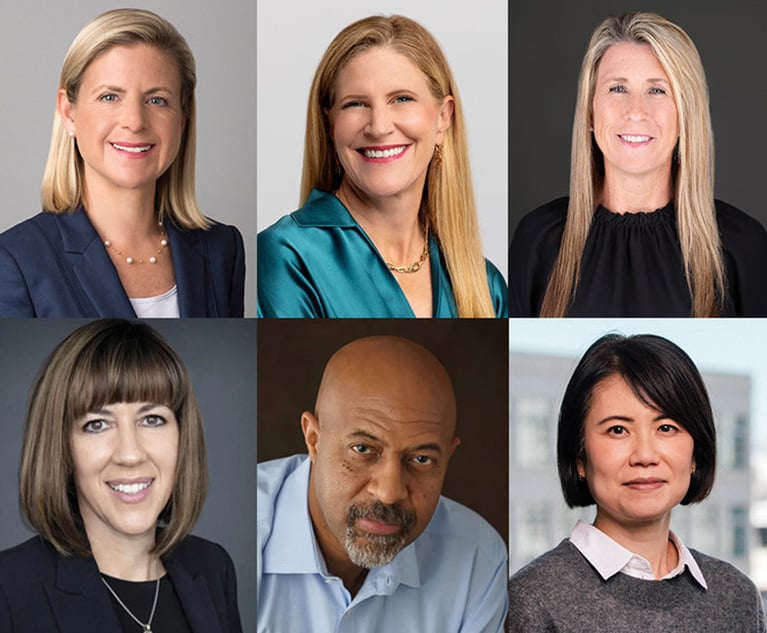Navigating the first 90 days: One leader’s approach
In companies of all sizes, newly hired or promoted leaders have a relatively short windowtypically 90 daysto make an impact.
November 21, 2013 at 07:00 PM
4 minute read
In companies of all sizes, newly hired or promoted leaders have a relatively short window—typically 90 days—to make an impact. Those first 90 days are written about in books and articles, which should be read with your own job in mind. Each role has different priorities, so create your own checklist based on your department's needs.
I recently interviewed Linda Lu, chief litigation officer of Nationwide Insurance. She started in March 2013 as one of four new direct reports to the company's general counsel. Her team has 55 attorneys and staff members who manage all corporate litigation. Linda described the process she used to learn about her team and the job while considering changes.
Goals and process
Linda had three main goals at the outset: 1) Learn what was working, and where there were opportunities; 2) determine whether the structure was on target or could be enhanced; and 3) begin making changes. She also used a deliberate process to achieve those goals: 1) Conduct interviews; 2) assess the results; 3) and decide on changes and implement.
Meetings
Linda personally met with over 75 people, including her team, her legal department peers and senior leaders of Nationwide. She asked questions about their impressions of: 1)The legal department and litigation group; 2) the litigation group's strengths and areas of opportunity for client service; and 2) which litigation associates stood out as impactful to business decisions.
Assess the Results
While the executives thought the litigation talent pool was strong, there was an opportunity to strengthen the partnerships with the business. As in most companies, litigators are perceived as naysayers. Therefore, litigators often are not invited to innovation sessions. As for engagement, Talent and roles were under-assessed, providing an opening to create leadership and growth opportunities.
Brainstorm
In June 2013, Linda and the litigation team leaders worked together to whiteboard what an optimal organization might look like: 1) To support talent development and create growth opportunities for her team; and 2) to guide litigation leaders in gaining a more global perspective to provide better client service. In addition, the group articulated a value proposition for internal and external visibility. They agreed that the team would enhance communication and develop processes that identify and help minimize risks. They would enhance collaboration with the company's business-facing lawyers who could help bring the litigation perspective to the table earlier.
Restructuring
The restructuring involved creating three new leadership positions to allow for a greater global perspective of the businesses they serve. The new leaders would have additional opportunities to build relationships organically. They would have a broader scope, broader influence and most importantly, be invited to the innovation table where they could add real value. In July and August 2013, before moving to actual restructuring, Linda socialized the reorganization with the litigation group's key business clients. She wanted to thank these leaders for their valuable input, be sure they agreed that the plan would actually address the issues discussed, and confirm that the new litigation leaders would be invited to the table.
In September and October, internal interviewing commenced to fill the new positions. On Oct. 30, the new litigation leadership team and their HR partners held a half-day summit to discuss team engagement and commit to working and playing well together.
Next Steps
The restructuring is complete but the jury is still out. Linda emphasizes that this was a team effort and about building relationships. In the meantime, Linda is open to talking about her process and progress to other in-house counsel who may benefit from her group's experience.
This content has been archived. It is available through our partners, LexisNexis® and Bloomberg Law.
To view this content, please continue to their sites.
Not a Lexis Subscriber?
Subscribe Now
Not a Bloomberg Law Subscriber?
Subscribe Now
NOT FOR REPRINT
© 2025 ALM Global, LLC, All Rights Reserved. Request academic re-use from www.copyright.com. All other uses, submit a request to [email protected]. For more information visit Asset & Logo Licensing.
You Might Like
View All
'A Warning Shot to Board Rooms': DOJ Decision to Fight $14B Tech Merger May Be Bad Omen for Industry

Exits Leave American Airlines, SiriusXM, Spotify Searching for New Legal Chiefs
2 minute read
'Incredibly Complicated'? Antitrust Litigators Identify Pros and Cons of Proposed One Agency Act
5 minute readTrending Stories
- 1LSU General Counsel Quits Amid Fracas Over First Amendment Rights of Law Professor
- 2An Eye on ‘De-Risking’: Chewing on Hot Topics in Litigation Funding With Jeffery Lula of GLS Capital
- 3Arguing Class Actions: With Friends Like These...
- 4How Some Elite Law Firms Are Growing Equity Partner Ranks Faster Than Others
- 5Fried Frank Partner Leaves for Paul Hastings to Start Tech Transactions Practice
Who Got The Work
J. Brugh Lower of Gibbons has entered an appearance for industrial equipment supplier Devco Corporation in a pending trademark infringement lawsuit. The suit, accusing the defendant of selling knock-off Graco products, was filed Dec. 18 in New Jersey District Court by Rivkin Radler on behalf of Graco Inc. and Graco Minnesota. The case, assigned to U.S. District Judge Zahid N. Quraishi, is 3:24-cv-11294, Graco Inc. et al v. Devco Corporation.
Who Got The Work
Rebecca Maller-Stein and Kent A. Yalowitz of Arnold & Porter Kaye Scholer have entered their appearances for Hanaco Venture Capital and its executives, Lior Prosor and David Frankel, in a pending securities lawsuit. The action, filed on Dec. 24 in New York Southern District Court by Zell, Aron & Co. on behalf of Goldeneye Advisors, accuses the defendants of negligently and fraudulently managing the plaintiff's $1 million investment. The case, assigned to U.S. District Judge Vernon S. Broderick, is 1:24-cv-09918, Goldeneye Advisors, LLC v. Hanaco Venture Capital, Ltd. et al.
Who Got The Work
Attorneys from A&O Shearman has stepped in as defense counsel for Toronto-Dominion Bank and other defendants in a pending securities class action. The suit, filed Dec. 11 in New York Southern District Court by Bleichmar Fonti & Auld, accuses the defendants of concealing the bank's 'pervasive' deficiencies in regards to its compliance with the Bank Secrecy Act and the quality of its anti-money laundering controls. The case, assigned to U.S. District Judge Arun Subramanian, is 1:24-cv-09445, Gonzalez v. The Toronto-Dominion Bank et al.
Who Got The Work
Crown Castle International, a Pennsylvania company providing shared communications infrastructure, has turned to Luke D. Wolf of Gordon Rees Scully Mansukhani to fend off a pending breach-of-contract lawsuit. The court action, filed Nov. 25 in Michigan Eastern District Court by Hooper Hathaway PC on behalf of The Town Residences LLC, accuses Crown Castle of failing to transfer approximately $30,000 in utility payments from T-Mobile in breach of a roof-top lease and assignment agreement. The case, assigned to U.S. District Judge Susan K. Declercq, is 2:24-cv-13131, The Town Residences LLC v. T-Mobile US, Inc. et al.
Who Got The Work
Wilfred P. Coronato and Daniel M. Schwartz of McCarter & English have stepped in as defense counsel to Electrolux Home Products Inc. in a pending product liability lawsuit. The court action, filed Nov. 26 in New York Eastern District Court by Poulos Lopiccolo PC and Nagel Rice LLP on behalf of David Stern, alleges that the defendant's refrigerators’ drawers and shelving repeatedly break and fall apart within months after purchase. The case, assigned to U.S. District Judge Joan M. Azrack, is 2:24-cv-08204, Stern v. Electrolux Home Products, Inc.
Featured Firms
Law Offices of Gary Martin Hays & Associates, P.C.
(470) 294-1674
Law Offices of Mark E. Salomone
(857) 444-6468
Smith & Hassler
(713) 739-1250







